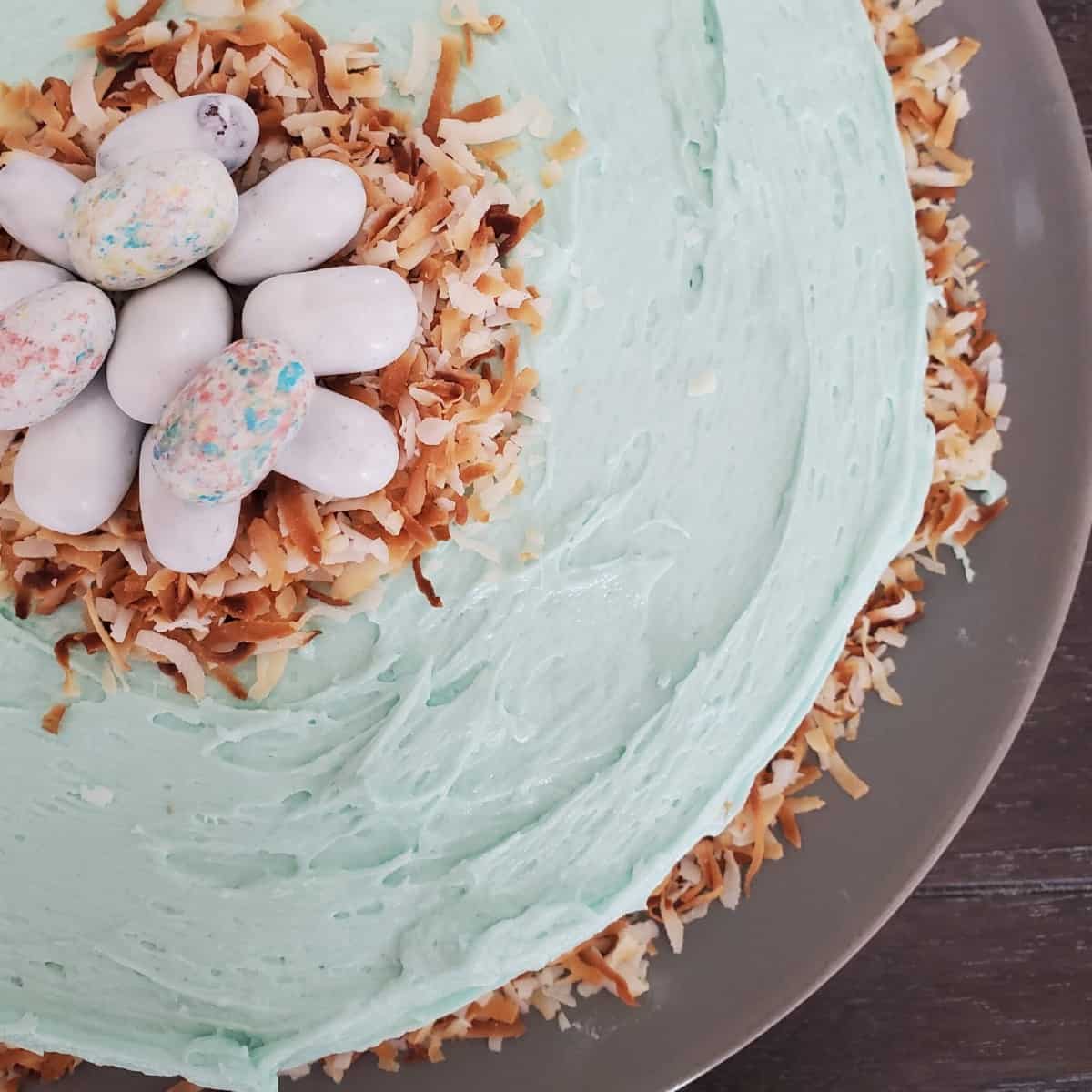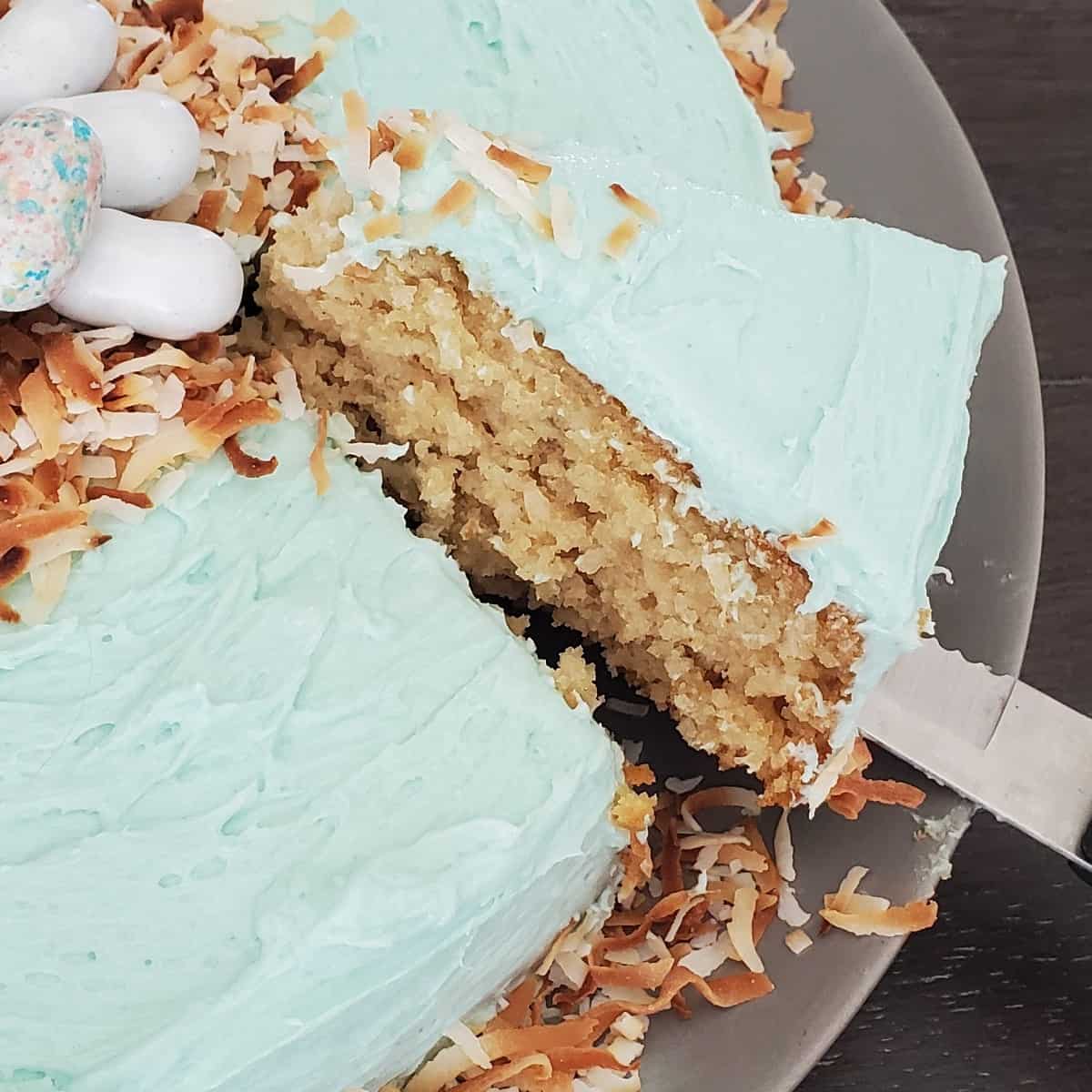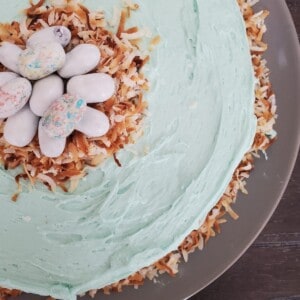Today you're going to learn how to make a coconut cake with flaky toasted coconut, a moist and delicious coconut flavored cake, and a rich coconut buttercream frosting. Let's get started!

Enjoy this cake anytime but it's the perfect cake for coconut lovers or as a summer time cake. You can even enjoy it as an Easter coconut cake!
Jump to:
Ingredients
My justification for this cake is due to being in social isolation with two kids, two teenagers, a husband and three dogs. Cake was needed. I might have taken it into my bedroom and come out with only half of it. This cake isn't my typical minimal ingredient cake but you can try a no bake cheesecake or this five ingredient carrot cake.
Easter Coconut Cake with Coconut Buttercream Frosting
- sugar
- butter
- oil
- flour
- cornstarch or arrowroot powder
- baking powder
- baking soda
- salt
- milk (can use coconut milk)
- eggs
- coconut extract
- vanilla extract
- shredded coconut (unsweetened or sweetened okay)
For the Frosting:
- butter
- powdered sugar
- salt
- coconut cream
- milk or coconut milk
Instructions
Cake Preparation:
- Preheat and Prepare:Begin by preheating your oven to 325 degrees. Lightly grease a six-inch round pan and set it aside for later use.
- Mixing the Batter:In a mixer set to low speed, combine sugar, butter, and oil until the mixture achieves a smooth consistency. Add in the flour, cornstarch or arrowroot powder, baking powder, baking soda, and salt. Stir well until all the ingredients are thoroughly combined.
- Incorporate Wet Ingredients:Stir in the milk, eggs, and extracts, continuing to mix until the batter is smooth and well-blended. Gently fold in the shredded coconut to infuse the batter with its tropical flavor.
- Baking Process:Pour the prepared batter into the greased six-inch round pan. Bake at 325 degrees for 25-30 minutes or until a toothpick inserted into the center comes out clean. This ensures the cake is perfectly baked.
- Cooling Stage:Once baked, remove the cake from the oven and allow it to cool for 15 minutes in the pan. Afterward, carefully remove the cake from the pan and transfer it to a cooling rack to cool completely before proceeding to the frosting stage.
- Frosting the Cake:Once the cake has thoroughly cooled, proceed to frost it with the coconut cream frosting, creating a deliciously decadent finish.
Coconut Cream Frosting:
- Whipping Up the Frosting:In a mixer, whip together softened butter, sugar, salt, and coconut cream until the mixture reaches a light and fluffy consistency.
- Adjusting Consistency:Add 1-2 tablespoons of coconut cream as needed to achieve the desired frosting consistency. This step ensures your frosting is both spreadable and lusciously smooth.
- Adding a Pop of Color: If desired, enhance the visual appeal of your frosting by tinting it with natural gel food color. This step adds a touch of vibrancy and creativity to your cake's presentation.
- Frost and Decorate:Spread the coconut cream frosting generously over the cooled cake. Once frosted, let your creativity shine by decorating the cake according to your preference.

Substitutions
If you have food allergies or intolerances, there are a few substitutions to make to this recipe:
- Gluten free: Use gluten free flour in place of the regular flour.
- Dairy free: To make this recipe dairy free, use dairy free butter and milk.
- Vegan: For a vegan version, use egg replacer in place of the eggs. Substitute plant based milk and butter.
Equipment
For this recipe you will want a cake pan and a mixer. The mixer will make the frosting light and fluffy.
Storing
Your cake can be stored in an airtight container for several days in the refrigerator or frozen in the freezer for up to one month.
FAQ
You can use either, depending on your preference. Sweetened coconut will add more sweetness to the cake, while unsweetened coconut allows you to control the sugar content.
You can make coconut milk by blending grated coconut with warm water and then straining the mixture. The liquid obtained is coconut milk.
Coconut cream is thicker and has a higher fat content than coconut milk. It's often used in desserts for a richer texture.
Be cautious not to overbake the cake. Follow the recommended baking time and check for doneness using a toothpick.
Coconut flour absorbs more liquid than all-purpose flour, so it's not a one-to-one substitute. If you want to use coconut flour, you may need to adjust the liquid content and possibly add more eggs.
Yes, you can freeze a coconut cake. Wrap it tightly in plastic wrap and then in foil before freezing. Thaw it in the refrigerator before serving.
Cream cheese frosting, coconut cream cheese frosting, or a simple vanilla buttercream are popular choices. Consider adding shredded coconut on top for extra texture.

How to Make a Coconut Cake
Equipment
- cake pan
- mixer
Ingredients
- 1 cups sugar
- ¼ cup butter melted
- ¼ cup oil
- 1 cup flour
- 2 tablespoons cornstarch or arrowroot powder
- ½ teaspoon baking powder
- ¼ teaspoon baking soda
- Pinch of salt
- ½ cup milk
- 3 eggs
- ½ teaspoon coconut extract
- ¼ teaspoon vanilla extract
- 1 cup shredded coconut unsweetened or sweetened
- For the Frosting:
- ¾ cup butter softened
- 2 ½ cups powdered sugar
- Pinch of salt
- 3 tablespoons canned coconut cream
- 1-2 tablespoon water
Instructions
- To Make the Cake: Preheat oven to 325 degrees. Lightly grease a six inch round pan and set aside. In a mixer set to low, mix together the sugar, butter and oil until smooth. Stir in the flour, cornstarch or arrowroot powder, baking powder, baking soda, and salt until stirred well. Stir in the milk, eggs, extracts, continuing to stir until smooth. Fold in the coconut.
- Pour batter into the pan. Bake at 325 degrees for 25-30 minutes or until a toothpick inserted into the center comes out clean. Remove the cake from the oven and allow to cool for 15 minutes before removing cake from pan and cooling on a cooling rack. Frost cake when cool.
- To make the frosting: In a mixer, whip together the butter, sugar, salt and coconut cream. Add 1-2 tablespoon as needed to frosting. Tint with natural gel food color if desired. Frost the cake, then decorate.


Leave a Reply